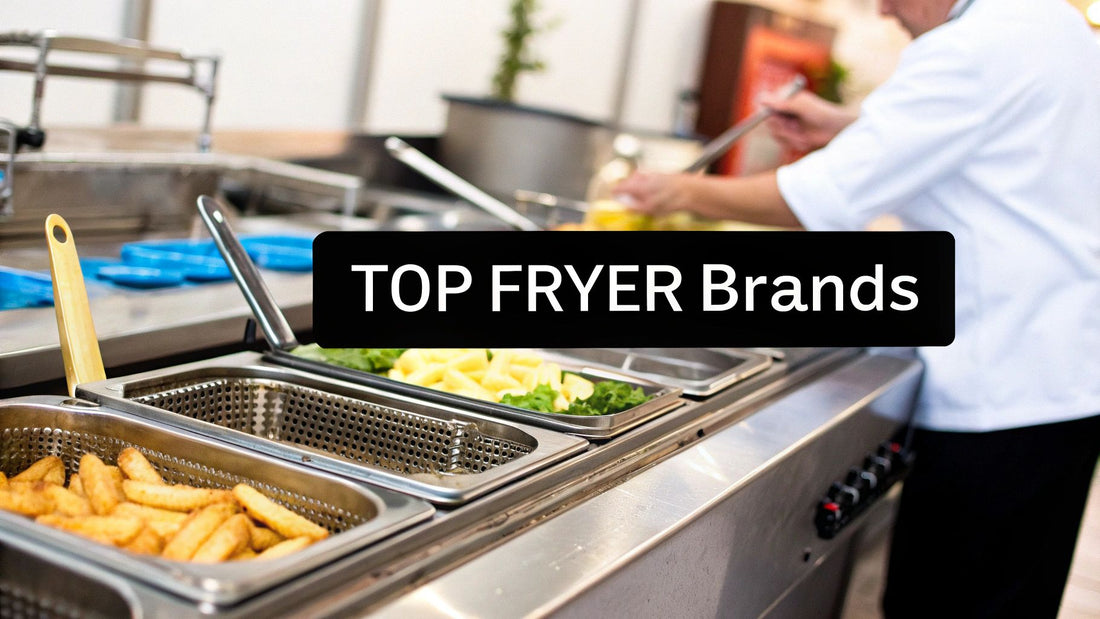
Discover the Best Deep Fryer Brands for Your Business
Share
Help restaurant owners and chefs discover the latest news and exclusive deals on restaurant equipment and supplies. Stay informed about industry trends, restaurant equipment, and supplies.
If you're in the market for a new commercial deep fryer, you've probably heard the big names: Pitco, Frymaster, and Henny Penny. These brands are the titans of the industry for a reason—they're known for building reliable, efficient machines that can handle the heat of a busy kitchen.
How to Choose the Right Commercial Deep Fryer
Picking a deep fryer isn't just another equipment purchase; it's a major investment that affects your food quality, kitchen workflow, and ultimately, your profits. This guide is designed to go beyond just listing brands and help you, as a restaurant owner or chef, figure out which fryer is actually the right fit for your operation. It’s the details that separate a decent fryer from a great one.
The commercial deep fryer market is massive—valued at around USD 573.63 million and still growing. This tells you just how central this piece of equipment is to the modern food service world. In North America, which accounts for a huge 38.3% of that market, high-volume frying is the engine behind countless fast-food chains and restaurants. It's a competitive space where top players like Ali Group SRL (who owns Frymaster) and Henny Penny are constantly innovating.
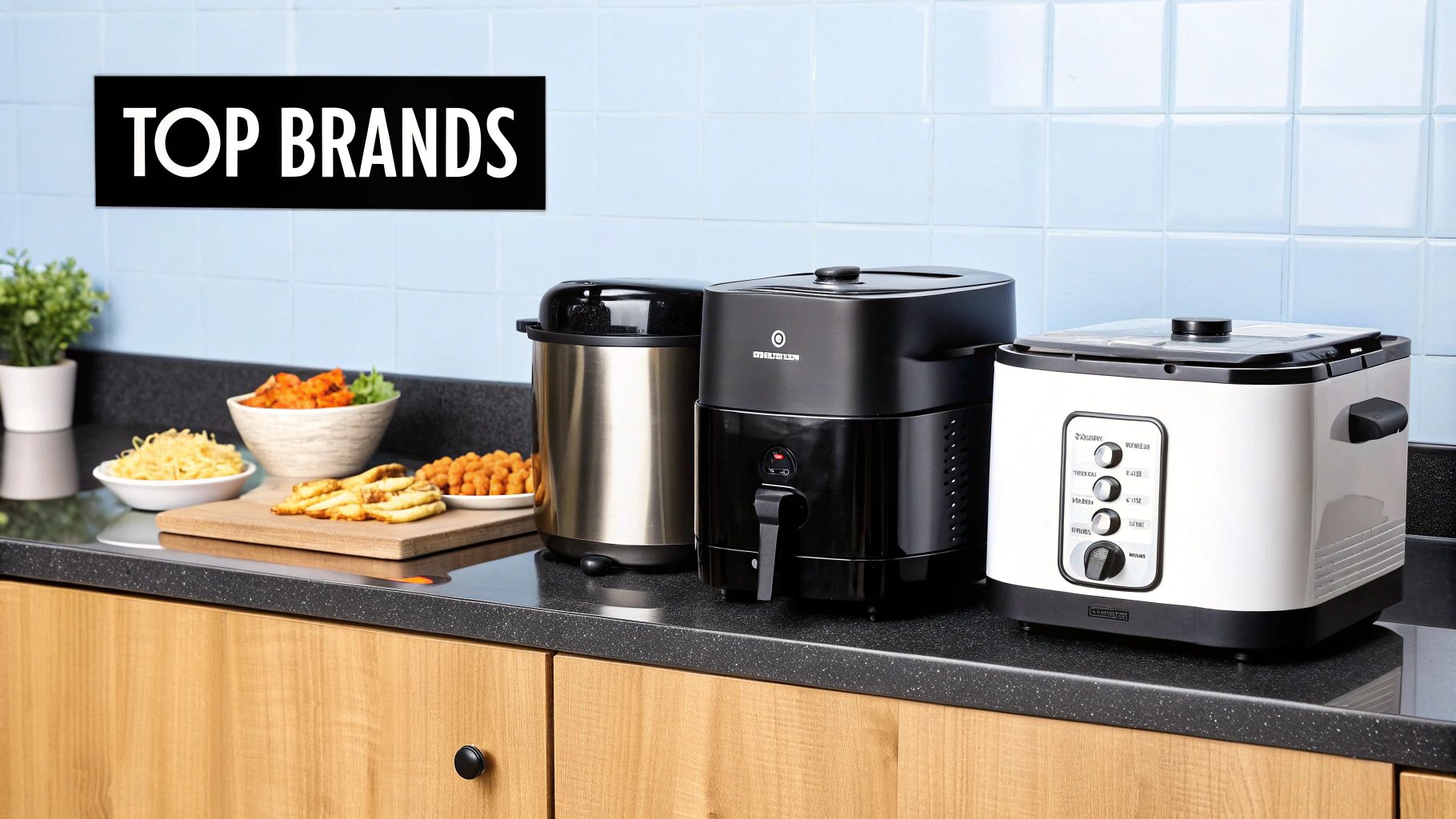
Key Decision Factors for Your Kitchen
Before we jump into a side-by-side comparison, let's nail down what your kitchen actually needs. Knowing your operational goals from the start makes it much easier to pick a machine that will boost your efficiency and turn out consistently great food. If you need a hand organizing your thoughts, our commercial kitchen equipment checklist is a great place to start.
We're going to look at how different brands stack up in various kitchen settings, from a slammed fast-food joint to a more specialized restaurant. You'll learn what to look for based on:
- The kind of food you’re actually frying.
- The sheer volume of fried food you push out every day.
- Your operational priorities, whether that's speed, energy efficiency, or saving on oil costs.
Think of this as your roadmap to making a smart, profitable decision for your business. Let's get into it.
What Really Makes a Great Commercial Fryer?
When you’re looking at the top deep fryer brands, it’s easy to get lost in the logos and marketing. But to make a smart buy, you need to dig into the specs that actually drive performance in a busy kitchen. Getting a handle on these core features is the key to matching a fryer to your specific needs, ensuring your investment improves both your food quality and your workflow.
From the power source to the shape of the fry pot, every little detail affects your fryer's daily output and how long it'll last.
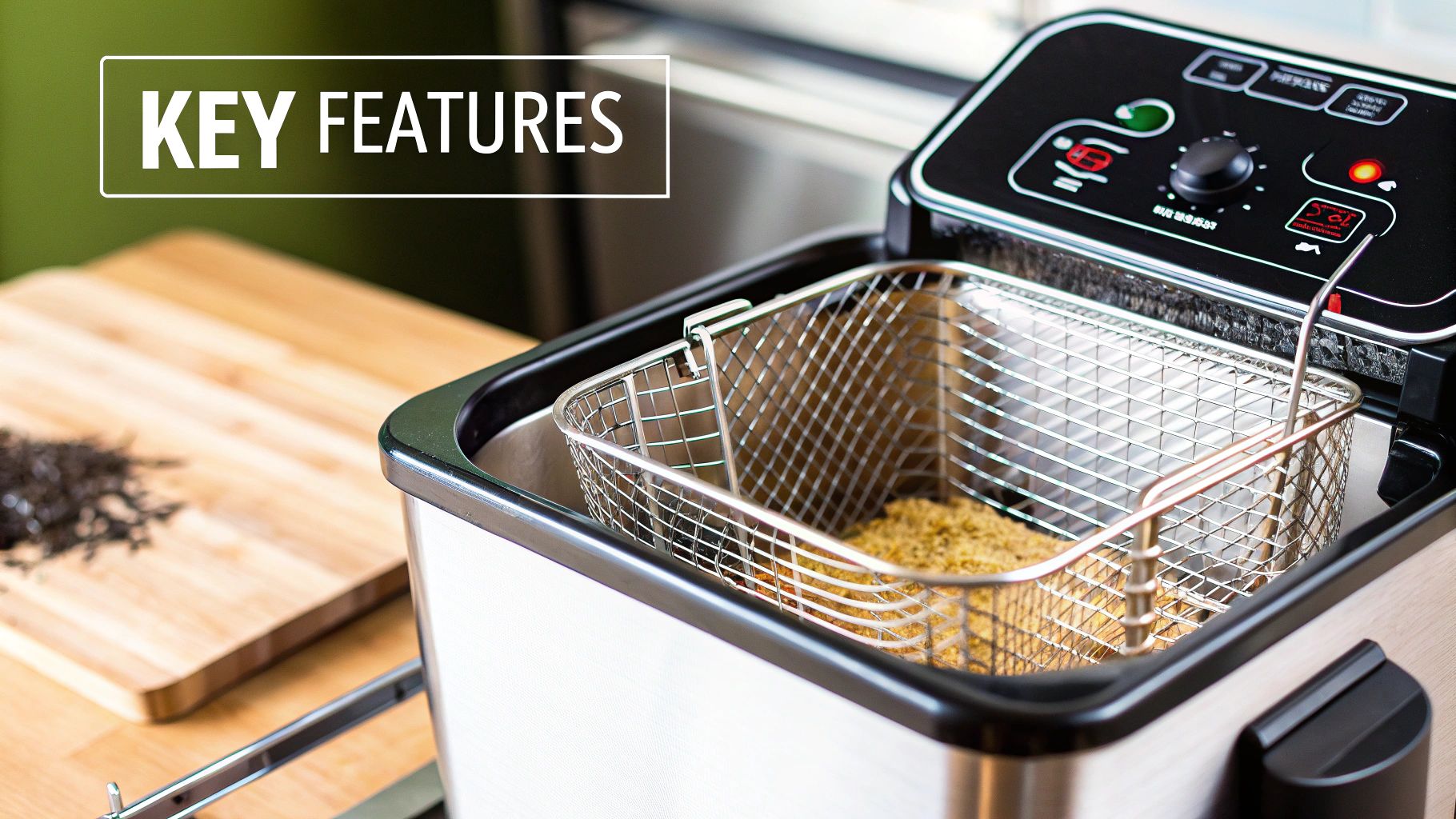
This is the kind of know-how that lets you see past the sales pitch and focus on what truly matters. It’s the difference between buying a fryer that just gets the job done and one that becomes a reliable workhorse for your kitchen.
Power Source: Gas vs. Electric
Your first big decision is whether to go with a gas or electric model. Gas fryers are the undisputed champions of the industry for a reason. They heat up incredibly fast and have an impressive recovery time—that’s how quickly the oil gets back to temperature after you drop in a basket of cold food. This raw power makes them perfect for high-volume kitchens that are constantly slinging frozen items like fries and wings.
Electric fryers, on the other hand, are all about precision. Their heating elements sit right in the oil, which gives you incredibly stable and even heat. This is the kind of control you need for delicate items like tempura or doughnuts, where even a small temperature swing can mess up the finished product.
The Bottom Line: If you're frying back-to-back, all day long, gas gives you the speed and power you need. If you're cooking delicate foods that demand perfect temperature control, an electric model will give you the consistency you’re looking for.
Why the Fry Pot Design Matters
The shape of the fry pot has a huge impact on how easy the fryer is to clean and how long your oil will last. Each design is built for a specific purpose.
- Tube-Pot Fryers: You'll see tubes running through the oil at the bottom of the pot. The clever part is the space underneath them, which creates a "cold zone." All the crumbs and sediment fall down there and don't burn, which keeps your oil cleaner for longer. These are fantastic for heavily breaded foods.
- Open-Pot Fryers: Just like they sound, these have a wide-open, smooth pot. They are, by far, the easiest to scrub down. Their versatility makes them a great all-around choice for anything that isn't heavily breaded.
- Flat-Bottom Fryers: These have a completely flat bottom, making them the go-to for specialty items that need to float freely, like funnel cakes or battered fish fillets. The design ensures delicate batters won't get stuck on any heating elements.
Picking the right pot design isn't just a small detail—it simplifies your daily cleaning routine and can seriously cut down on your annual oil costs.
Performance, Power, and Money-Saving Systems
Looking beyond the basics, there are two more things that really separate a good fryer from a great one: its BTU rating and its oil filtration system. A higher BTU (British Thermal Unit) rating on a gas fryer means it heats up and recovers faster, which translates directly to more food out the window during your busiest rushes.
Even more important for your bottom line is an integrated oil filtration system. This feature is a game-changer for managing costs. Built-in systems make the daily chore of filtering oil fast, safe, and simple—often finishing the job in just a few minutes. By filtering your oil properly every day, you can slash your annual oil spending by as much as 50%. That makes a fryer with built-in filtration a seriously smart investment for any professional kitchen.
Comparing The Top Commercial Fryer Brands
Trying to sort through the best commercial deep fryer brands can feel like a chore, but three names consistently stand out for their performance and reliability: Pitco, Frymaster, and Henny Penny. Each one has carved out a specific niche by focusing on different kitchen needs. Understanding what sets them apart is the key to picking a fryer that doesn't just cook food, but actually improves your kitchen’s efficiency and bottom line.
This breakdown will get into the nitty-gritty of what makes each of these industry leaders tick. We'll go beyond basic feature lists to look at real-world situations, helping you see which brand’s design and engineering philosophy fits your menu, customer volume, and business goals. Whether you need a rugged workhorse, an oil-saving innovator, or a specialized machine, your perfect match is here.
Pitco: The Indestructible Workhorse
Pitco has earned its legendary status by sticking to one core principle: durability. For decades, chefs have relied on Pitco fryers to take a beating in the busiest kitchens and just keep going. They are the definition of a workhorse, built with straightforward, tough components that value longevity over flashy, complicated features.
Their Solstice Supreme series is a perfect example of this. These fryers are engineered with a patented self-cleaning burner and downdraft protection, which means you get reliable ignition and efficient heating, shift after shift. The focus on mechanical simplicity often means easier maintenance and fewer calls to the repair guy over the fryer's lifetime.
Pitco's real strength is its unwavering reliability. It's the brand you buy when you absolutely need a fryer that will fire up and perform flawlessly through every single service, no matter how intense, for years on end.
Think about a high-traffic sports bar or a bustling 24-hour diner. For a place like that, frying a huge variety of appetizers, wings, and fries, a bank of Pitco fryers is a smart investment. Their dependable nature translates to less downtime and consistent food quality, which is everything when the ticket machine is spitting out orders nonstop.
Frymaster: The Tech-Forward Innovator
While Pitco has mastered reliability, Frymaster leads the pack in technology and operational efficiency. This brand is laser-focused on developing features that save restaurant owners serious money on two of their biggest costs: oil and energy. Frymaster is for the operator who watches every dollar and sees their fryer as a tool for boosting the bottom line.
Their innovations are both practical and powerful. For example, Frymaster's oil-conserving frypots use a smaller cool zone and a smarter heat transfer system. This lets them cook the same amount of food with up to 40% less oil than older models, leading to massive savings over time. On top of that, their high-efficiency burners are designed to absorb more heat, which slashes idle energy use and lowers your utility bills.
This brand is a natural fit for Quick-Service Restaurants (QSRs) and large chains where consistency and cost control are top priorities. A busy fast-food joint frying thousands of pounds of french fries every week would see an immediate and significant return on investment from a Frymaster system. The advanced computer controls also guarantee that every single batch is cooked to the exact same standard—a must for maintaining brand quality across multiple locations.
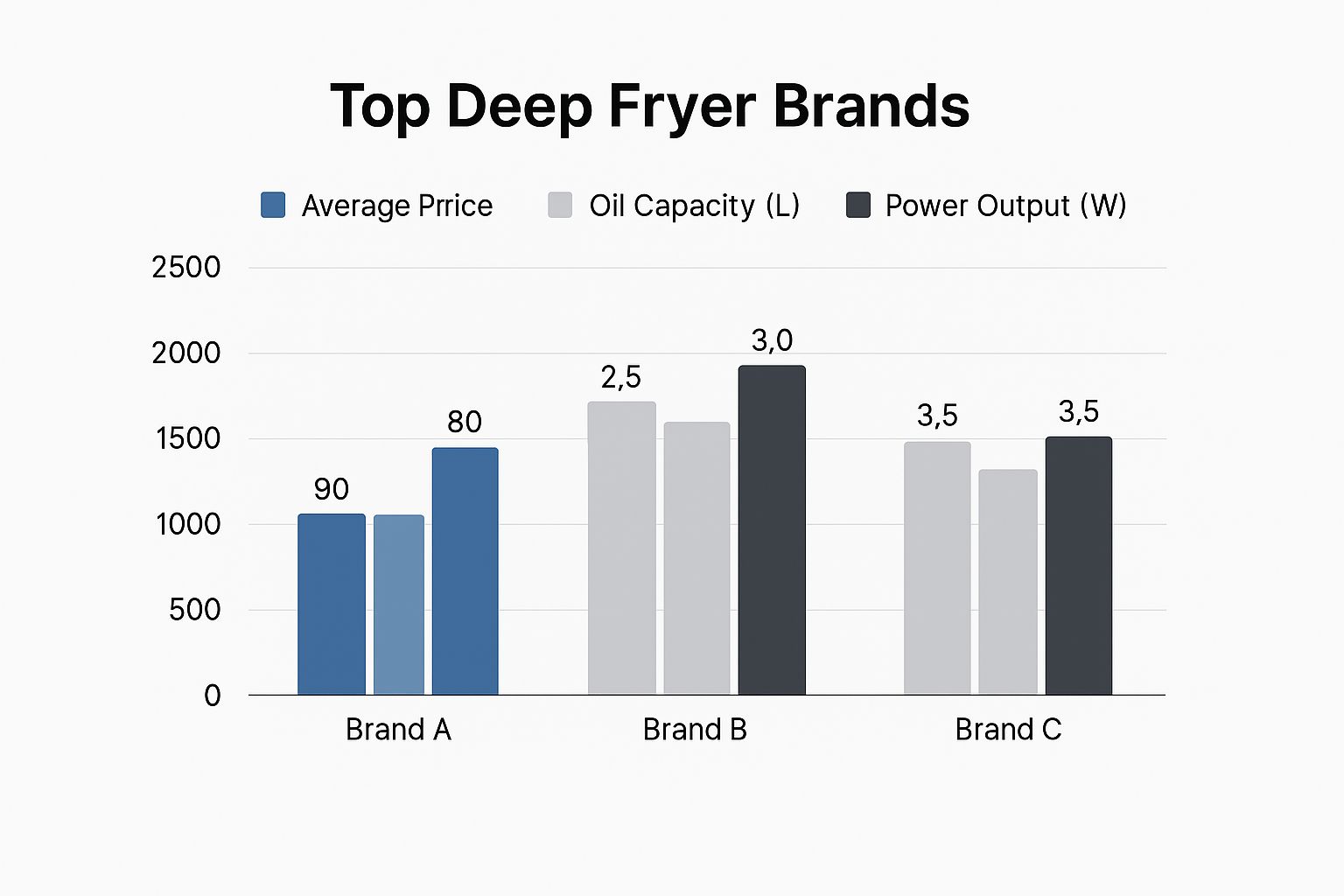
Henny Penny: The Pressure Frying Specialist
Henny Penny holds a unique and commanding spot in the market as the undisputed king of pressure frying. While other brands offer all-purpose solutions, Henny Penny has perfected a specialized technology that creates something no open fryer can: unbelievably moist, tender fried chicken with a perfectly crisp skin.
Pressure frying works by cooking food inside a sealed, pressurized chamber. This simple trick traps the food's natural moisture, preventing it from escaping as steam. The result? The product cooks faster and at a lower temperature, all while absorbing a lot less oil. The final product is healthier, juicier, and has become the gold standard for fried chicken restaurants around the world.
Their equipment, like the legendary PFE 500 series, is purpose-built for this job. It includes sophisticated pressure-locking mechanisms, multi-stage filtering, and programmable controls designed to perfect signature chicken recipes. Honestly, for any business where fried chicken is the main event, choosing Henny Penny isn't really a choice—it's a necessity.
A specialty chicken shop, a Southern-style restaurant, or even a catering company looking to make a name for itself would build their entire kitchen around a Henny Penny pressure fryer. The premium quality and unique texture it delivers can become a powerful brand differentiator, justifying a higher price point and building a fiercely loyal customer base.
Brand Performance Snapshot
To help you see the bigger picture, here’s a quick-glance table comparing how these three powerhouses stack up. This isn't about which one is "best," but which one is best for your kitchen.
| Brand | Core Strength | Ideal Kitchen Type | Signature Technology | Investment Level |
|---|---|---|---|---|
| Pitco | Unmatched durability and mechanical simplicity. | High-volume, all-purpose kitchens (diners, sports bars). | Solstice self-cleaning burners for consistent performance. | Moderate to High |
| Frymaster | Oil and energy efficiency through advanced tech. | QSRs, chains, and cost-conscious operations. | Oil-conserving frypots and high-efficiency burners. | High |
| Henny Penny | Specialized pressure frying for superior moisture. | Fried chicken concepts and specialty restaurants. | Patented pressure-locking systems and automated filtration. | High |
Ultimately, choosing between these brands comes down to aligning their strengths with your business strategy.
- A Pitco fryer offers peace of mind through its rugged, never-quit dependability.
- A Frymaster gives you a clear path to lower operating costs with smart, efficient technology.
- A Henny Penny provides the specialized tool you need to create a world-class signature product.
By carefully considering your menu, volume, and financial goals, you can confidently pick the brand that will be a true partner in your kitchen's success.
What's New in Commercial Frying Tech?
The world of commercial deep fryers never sits still. Manufacturers are constantly pushing for better efficiency, improved safety, and the kind of flexibility modern kitchens demand. If you're a restaurant owner or chef, keeping up with these changes is how you make a smart investment that pays off for years to come.
These days, the most exciting developments are happening in a few key areas. From ventless designs that fit anywhere to smart controls that take the guesswork out of cooking, today's fryers are solving real-world problems like tight kitchen space and soaring energy bills.
Ventless and Countertop Fryers Are Changing the Game
One of the biggest shifts we've seen is the explosion of high-quality ventless and countertop fryers. Think about it—these units completely eliminate the need for a traditional, expensive ventilation hood. Suddenly, businesses that couldn't offer fried food now can. We're talking about food trucks, small cafes, kiosks, and even ghost kitchens.
This is a huge deal. The ability to add fried items to a menu without a massive kitchen renovation is driving serious growth, with some estimates putting the market growth rate at around 9.8% CAGR. This innovation is fueling entrepreneurship and letting established spots broaden their menus with almost no downtime. You can get a deeper look at the market's direction and discover deep fryer industry insights on grandviewresearch.com.
Of course, figuring out where to put this new equipment to keep your kitchen running smoothly is a science in itself. It's a critical part of any effective commercial kitchen design and layout.
Say Goodbye to Guesswork with Smart Controls and Auto-Filtration
It's not just about size and placement anymore; the brains inside modern fryers are getting a serious upgrade. Smart controls and automated features are moving from high-end novelties to standard equipment, giving chefs a level of precision that was once impossible.
- Programmable Cooking Cycles: You can now program the exact time and temperature for every single item on your menu. This means every order of wings, fries, or onion rings comes out perfect, every time. It’s a simple way to slash human error and lock in consistency.
- Automated Filtration: Let's be honest, nobody enjoys filtering fryer oil. It's messy, dangerous, and time-consuming. New systems automate the whole process. With the push of a button, the fryer can clean its own oil in just a few minutes, which saves labor, extends the life of your oil, and makes your food taste better.
- Data and Diagnostics: Some of the most advanced fryers now track oil usage, keep an eye on their own parts, and send you alerts when maintenance is needed. This helps you manage costs and fix small problems before they become big ones.
This isn't just about bells and whistles. These smart features give you total operational control. You can cut down on waste, keep your quality high, and run a safer, more efficient kitchen—all of which shows up on your bottom line.
Induction Heating: The Future of Energy Efficiency
Another major leap forward is the use of induction heating. Traditional gas and electric fryers heat an element, which then heats the oil. Induction is different. It uses a magnetic field to heat the fry pot directly. Almost no energy is wasted heating the air around the fryer.
The result? Insanely fast heat-up and recovery times, plus incredibly precise temperature control. More importantly, this efficiency can slash your energy consumption by up to 35% compared to standard electric fryers. For any operator keeping an eye on utility bills and sustainability, induction fryers are an investment that really makes sense for the long haul.
Matching Fryer Brands to Your Business Needs
Picking the right deep fryer isn’t about finding a single “best” brand. It’s about matching the right tool to the job you need it to do. All those technical specs and brand reputations we’ve talked about translate directly into how a fryer performs on the line, day in and day out. When you align a fryer’s strengths with your menu, volume, and kitchen flow, you’re not just buying equipment—you're making a smart investment.
This guide will walk you through common kitchen scenarios, connecting each one to the brand and model that makes the most sense. Think of it as a practical cheat sheet for turning specs into a profitable kitchen workhorse.
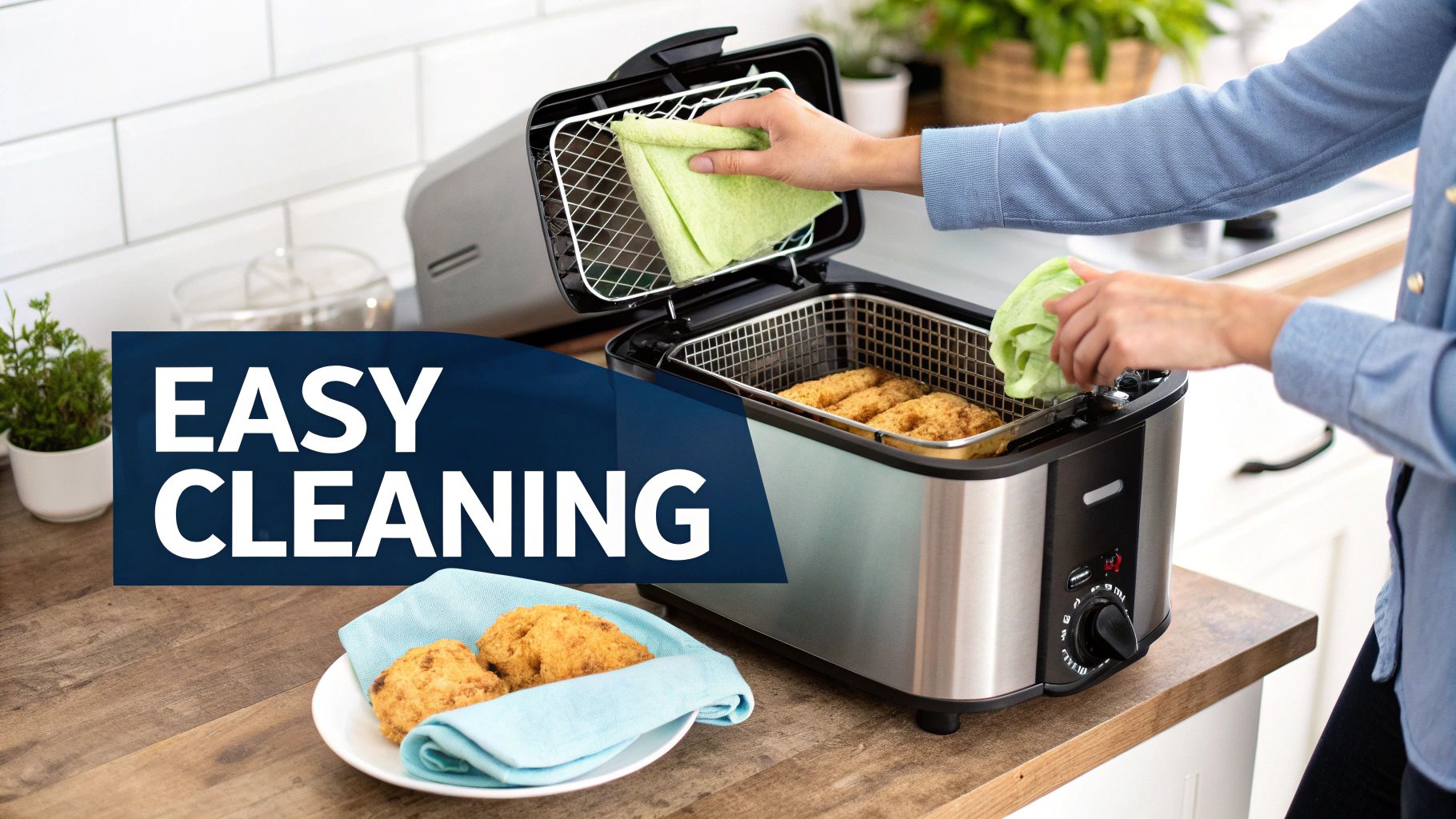
It's no surprise that this equipment is a staple in modern foodservice, and the market reflects that. Projections show the commercial deep fryer market is set to grow from USD 583.92 million to USD 798.24 million by 2032, largely thanks to the expansion of fast-food chains. Technology is also pushing things forward, with features like AI-powered temperature control and programmable settings becoming more common to make kitchens more efficient.
The High-Volume Fast-Food Chain
For any fast-food operation, it all boils down to three things: throughput, consistency, and cost control. When you're cranking out thousands of pounds of fries and chicken nuggets every week, every second and every drop of oil has a direct impact on your bottom line.
- Ideal Brand: Frymaster
- Recommended Model: A bank of Frymaster OCF30 high-efficiency tube fryers.
- Why It Works: Frymaster’s obsession with oil conservation and energy efficiency is tailor-made for this environment. The OCF30’s design is a game-changer; it cooks with just 30 lbs of oil in a pot that would typically require 50 lbs, leading to massive long-term savings. Add in its automated filtration and computer controls, and you get perfect consistency in every batch—a non-negotiable for chain operations.
The Bustling Sports Bar
A sports bar kitchen is pure, controlled chaos. The menu is diverse and the demand is relentless, especially during a big game. From wings and mozzarella sticks to onion rings and battered fish, you need a fryer that's a versatile and indestructible workhorse.
- Ideal Brand: Pitco
- Recommended Model: Pitco Solstice Supreme SSH Series.
- Why It Works: Pitco’s reputation for durability is legendary for a reason. The Solstice Supreme is built like a tank to withstand the brutal pace of a bar kitchen. Its powerful burners deliver incredibly fast recovery times, which means food stays crispy even when the kitchen is getting hammered with orders. The tube-pot design is also perfect for handling items with heavy breading, like most classic appetizers.
For a sports bar, the winning formula is versatility and reliability under pressure. A Pitco fryer delivers on both, giving you the rugged performance you need to crush a varied menu without missing a beat during those peak hours.
The Fine-Dining Restaurant
In a fine-dining kitchen, precision is everything. Chefs preparing delicate tempura, seafood, or intricate garnishes simply can't tolerate temperature swings that would ruin the texture and presentation of a dish.
- Ideal Brand: Dean (a Frymaster brand) or a comparable electric model.
- Recommended Model: An electric open-pot fryer like the Dean SR142E.
- Why It Works: When it comes to temperature stability, electric fryers are king. The heating elements are submerged directly in the oil, providing exceptionally even and consistent heat that is gentle on delicate batters. The open-pot design is also the easiest to clean—a critical factor in a high-end kitchen where preventing any flavor transfer is a top priority.
The Specialty Fried Chicken Concept
If fried chicken is the star of your show, your entire reputation rests on one thing: a product that is perfectly crispy on the outside and unbelievably moist on the inside. That kind of result isn't an accident; it requires specialized equipment.
- Ideal Brand: Henny Penny
- Recommended Model: A Henny Penny PFE 500 Pressure Fryer.
- Why It Works: Henny Penny is the undisputed champion of pressure frying. By cooking in a sealed environment, the fryer locks in moisture, creating a juicier, more tender product that you just can't get from an open fryer. This technology isn't just a piece of equipment; it's a powerful competitive advantage that helps you create a signature item that keeps customers coming back.
Of course, having the right equipment is only half the battle. To really succeed in a competitive market, you also need effective marketing. For some practical advice on boosting your online presence, check out these actionable digital marketing tips for small business success.
Frequently Asked Questions About Commercial Fryers
Making a big equipment purchase like a commercial fryer always comes with a few last-minute questions. It's a major decision, after all. To help you feel completely confident in choosing from the best deep fryer brands, we've pulled together some of the most common things we hear from chefs and owners. Think of this as the final checklist before you commit.
How Often Should I Filter My Fryer Oil?
The short answer? At least once a day, typically after your dinner rush wraps up. But let's be realistic—if your kitchen is pushing out a high volume of heavily breaded items like fried chicken or onion rings, filtering twice daily is the way to go.
Thankfully, most modern fryers come with built-in filtration systems that make this a quick, five-minute job. Staying on top of this routine gets rid of all the tiny food particles that cause oil to break down faster. It's a simple step that directly saves you a ton of money on oil and keeps your food tasting crisp and clean.
What Is the Difference Between Standard and High-Efficiency Fryers?
The real difference is under the hood—it's all about how the burners and heat exchangers are designed. A high-efficiency (HE) fryer is engineered to get more heat into the oil and lose less of it up the exhaust vent. It's just a smarter, more effective design.
Yes, HE fryers cost more upfront, but they can slash your gas consumption by 30-50%. That adds up to serious long-term savings on your utility bills. They also recover their temperature much faster, which is a game-changer for keeping up with orders during a rush and serving up a better, less greasy product.
A high-efficiency fryer is an investment in your operational budget. The upfront cost is quickly offset by lower monthly gas bills and improved product consistency, making it a financially sound choice for most busy kitchens.
Is a Gas or Electric Fryer Better for My Restaurant?
This one really comes down to your kitchen's setup, your menu, and how much you're frying. For most high-volume spots, gas is the undisputed king. Gas fryers heat up faster and have quicker recovery times, which is exactly what you need when you're dropping basket after basket of frozen fries.
Electric fryers, on the other hand, are the masters of precision. They hold a much steadier temperature, which is ideal for delicate items like tempura or doughnuts where even a small temperature dip can ruin the result. They're also a great option if you don't have a gas line run to a specific spot or need an extra fryer just for specialty items.
What Does Fryer Recovery Time Mean and Why Is It Important?
Recovery time is simply how long it takes the oil to get back to the perfect cooking temperature after you've dropped in a basket of cold food. It’s easily one of the most important things to look at in a fryer.
Why? Because a fast recovery time is the secret to consistently crispy food. If the oil stays too cool for too long, food just soaks it up and turns out soggy and greasy. The best deep fryer brands design their high-performance models for lightning-fast recovery to keep up with the pace of a real kitchen. This ensures every order comes out just right. Of course, proper upkeep is also key; for more on that, check out our guide on commercial kitchen equipment maintenance to get the most out of your gear.
At Encore Seattle Restaurant Equipment, we know that having the right tool for the job is what makes a kitchen run smoothly. Our team has the hands-on experience to help you find the perfect fryer from the industry's top brands—one that fits your menu, your volume, and your budget.
Explore our extensive collection of new and used commercial fryers at encoreseattle.com
